![]()
Tue, Dec 18, 2012 | terrorism-info.org.il
Appendix II — Hezbollah’s Terrorist Activities during the 1990s
Hezbollah has a 30-year history of terrorist activity in Lebanon, the Middle East and around the globe, directed against Israel, the Jewish people, the United States and the West, pro-Western Arab states and Hezbollah’s enemies in Lebanon. This study is published by The Meir Amit Intelligence and Terrorism Information Center. You can download the full study in PDF format here.
Overview
In the 1990s Hezbollah combined terrorist attacks in Israeli territory and overseas with guerilla warfare against the IDF in the Lebanese security zone and sporadic rocket fire at Israel. The terrorist attacks inside Israel were meant to undermine the Oslo Accords and challenge the Palestinian Authority, which supported the Hamas-led Palestinian campaign of terrorism. The terrorist attacks abroad were carried out in retaliation for the IDF’s attacks on Hezbollah, handicapping Israel’s fight against terrorism. The guerilla warfare in the security zone was intended to inflict casualties on the IDF, force it to and thus allow Hezbollah to complete its takeover of south Lebanon. The fight against the security zone, which was perceived as a success for Hezbollah, led to the IDF’s withdrawal from Lebanon on May 24, 2000, after which it deployed along the international border (the UN Blue Line).
Of the terrorist attacks carried out by Hezbollah outside of Israel, three were mass-casualty suicide bombing attacks against Israeli/Jewish targets in 1992 – 1994: two suicide bombing attacks carried out in Argentina, one on the Israeli embassy and the other on the Jewish community building (AMIA), were considered successful by Hezbollah, while another terrorist operation against the Israeli embassy in Thailand failed.
In addition to global terrorist operations, Hezbollah tried to carry out terrorist attacks in Israeli territory. To that end it used Shiite Lebanese operatives sent from Europe in the second half of the 1990s and in 2000 – 2001. Notable was the case of Hezbollah operative Hussein Mikdad, who was sent to Israel to carry out a showcase terrorist attack (he was severely injured in a “work accident” while assembling an IED in his Jerusalem hotel).
The Global Arena
Hezbollah’s terrorist attacks in Argentina (1992, 1994)
The Car Bombing of the Israeli Embassy in Buenos Aires, 1992
On March 17, 1992, a pickup truck packed with about 300 kilos, or 660 lbs, of TNT and driven by a suicide bomber blew up in front of the Israeli embassy building in Argentina. The explosion destroyed a large part of the building. Twentynine Israelis and Argentineans were killed and about 250 people were injured. In addition, severe damage was caused to nearby buildings and cars.
“Islamic Jihad” (a fictitious name used by Hezbollah) claimed responsibility for the attack, claiming it was in revenge for the IDF killing of Hezbollah leader Sheikh Abbas Musawi the previous month (Sheikh Abbas Musawi died in a targeted killing in February 1992, about one month before the terrorist attack in Argentina).
The Scene of the Attack
In May 1999 the Argentinean Supreme Court concluded its investigation, and having determined that Hezbollah was responsible for the attack, issued a warrant for the arrest of Imad Mughniyeh, commander of Hezbollah’s militaryterrorist wing (Mughniyeh died in Damascus in 2008). An investigation carried out by Israel, whose results were made public in 2003 by former Israeli Foreign Minister Silvan Shalom, showed that the highest levels of the Iranian regime knew about the intended terrorist attack and authorized Hezbollah to carry it out.
Silvan Shalom told a press conference that it was clear to Israel that Hezbollah, using its external operations apparatus commanded by Imad Mughniyeh, had been responsible for the terrorist attack on the Israeli embassy in Buenos Aires (Ynet.co.il website). In his book From Terror to Nuclear Bombs (Hebrew), Ephraim Kam wrote that several communications sent to and from the Iranian embassy in Buenos Aires two weeks before the terrorist attack and intercepted by the American intelligence community, indicated that Iran was directly involved in the attack.[40]
The Car Bombing of the Jewish Community Building (AMIA), 1994
Overview
On July 18, 1994, at 9:53 in the morning, a powerful blast shook the Jewish community center (AMIA) building in Buenos Aires, killing 85 people in and around the building and wounding more than 300. A large part of the building collapsed and nearby buildings were damaged as well. The investigation revealed that the explosion had been caused by a suicide bomber driving a Renault van packed with about 400 kilograms (880 lbs) of explosives, which blew up near the building entrance. It took several weeks to evacuate the bodies.
The AMIA bombing was preceded by two Israeli strikes against Hezbollah: the abduction of Mustafa Dirani from Lebanon on May 21, 1994, and the killing of 26 Hezbollah operatives in an attack on the organization’s training camp in the east Lebanese village of Ein Dardara (June 2, 1994). Hezbollah leaders commented that the organization had the ability to retaliate abroad. For instance, about one month before the AMIA bombing, Hezbollah leader Hassan Nasrallah was quoted as saying that “one thousand suicide commandoes are ready to strike Israel across the entire globe” (Al-Watan al-Arabi, June 17, 1994). Khader Tleis, a parliament member for Hezbollah, said after the attack in Ein Dardara Israel knew that Hezbollah could “do a lot even outside Lebanon,” and threatened that Israel would be hit “in and outside of Lebanon.”
The Main Findings of the Argentinean Investigation
On October 25, 2006, Argentinean attorney general Dr. Alberto Nisman and prosecutor Marcelo Martínez Burgos revealed the findings of the Argentinean investigation. The findings were issued in an 800-page report and the main points were revealed at a press conference: the investigation unequivocally determined that the decision to bomb the AMIA building had been made by the leadership of the Iranian regime and carried out by Hezbollah, Iran’s proxy for implementing its policies.
In light of the report, the Argentinean prosecution asked Judge Rodolfo Canicoba Corral to issue international arrest warrants for seven high-ranking members of the Iranian regime and one senior Hezbollah terrorist operative, all involved in the terrorist attack. One of the seven, some of whom still serve in high positions in the Iranian regime, was Ahmad Vahidi, today Iran’s defense minister and Qods Force commander at the time (1994). A warrant was not issued for the arrest of Supreme Leader Ali Khamenei, possibly for political considerations, even though the report explicitly stated that he had been party to the decision to carry out the attack.[41]
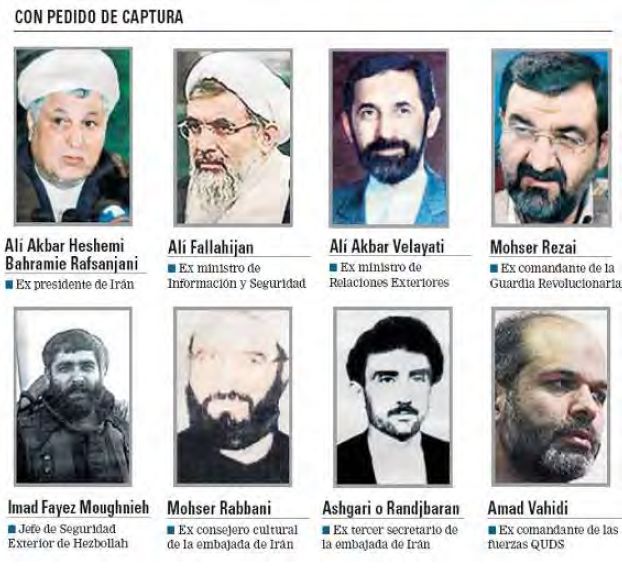
The seven high-ranking Iranians and the senior Hezbollah operative for whom the Argentinean prosecution asked for arrest warrants (Imad Mughniyeh, who commanded Hezbollah’s militaryterrorist apparatus, is at the lower left).
Hezbollah’s Role, according to the Argentinean Attorney General’s Report[42]
The report states that the decision to carry out the attack was adopted at the highest level of the Iranian government. Its main points regarding Hezbollah are the following:
- The report describes in detail how the Iranian upper echelons arrived at the decision to carry out the attack. It was the work of a group called the Special Affairs Committee, whose members at that time were Ali Khamenei, Ali Rafsanjani, Ali Fallahian and Ali Velayati. They met in the Iranian city of Mashhad on August 14, 1993 and decided to carry out a terrorist attack in Argentina. The highest ranks of the Iranian regime ordered Hezbollah to carry out the attack against AMIA. The Iranian regime employed Hezbollah’s terrorist infrastructure.
- The attack was carried out by a Hezbollah operational squad which arrived in Argentina on July 1, 1994. Imad Mughniyeh, head of Hezbollah’s External Security Service, was responsible for running the squad and to that end visited Argentina at the beginning of July 1994. The Argentineans have records of many phone conversations between Imad Mughniyeh, Hezbollah’s operational squad, Hezbollah operatives in Lebanon, and Hezbollah’s network in the Brazilian side of what is known as the tri-border region.[43] On July 18 the last call received by Imad Mughniyeh’s cell phone was recorded and indicated that the attack had been carried out.
- At 09:53 on the morning on July 18 a suicide bomber named Ibrahim Mohsen Berro blew himself up inside a Renault van carrying 300-400 kg (660-880 lbs) of explosives (Note: The Berros are a Shi’ite family in south Lebanon, some of whose members have links to Hezbollah and are involved in international drug trafficking). The report states that the method of the attack was identical to the one employed two years before in the attack on the Israeli embassy in Buenos Aires carried out by Hezbollah.
On November 10, 2006, Argentina’s attorney general asked for international arrest warrants for the eight Iranians on the grounds that they had committed “a crime against humanity.” Two weeks later Argentina asked Interpol to issue the warrants. Interpol, having studied the evidence presented by Argentina and Iran, agreed to issue them.
The Failure of the Attempted Bombing of the Israeli Embassy in Thailand (1994)
Overview
In March 1994 a suicide bomber attempted to carry out a car bomb attack on the Israeli embassy in Thailand. The terrorist attack was similar to the bombing of the Israeli embassy in Argentina in March 1992 and of the Jewish community building in Argentina in July 1994. All the attacks were carried out by Hezbollah operatives with Iranian assistance.
The following is the information we have on the attempted terrorist attack:[44]
- On March 11, 1994, a suicide bomber came within 240 meters of driving a van laden with explosives into the Israeli embassy in Bangkok. As he exited an underground parking lot he crashed into a motorcycle taxi, panicked and fled the scene. When police inspected the van, they found a water tank filled with approximately 1,000 kg (2,200 lbs) of fertilizer, two oil containers, a battery and C-4 plastic explosives. They also found two switches beneath the driver’s seat, apparently wired to detonate the explosives.
- After removing the explosives from the tank, police also discovered a dead body. The van’s owner recognized the body as one of her local drivers and said that she had rented the vehicle with the driver. Apparently he was murdered at some point by the Hezbollah terrorists who had rented the truck, and his body was placed in the explosive-filled tank. Had the bomb gone off as planned, his death would not have been discovered.
- A group of Thai Hezbollah collaborators involved in the terrorist attack was exposed in 1999 with the arrest of Pandu Yudhawinata, a Hezbollah operative from Indonesia. Pandu was arrested in the Philippines as he stepped off a Philippines Airlines flight from Zamboanga City to Manila. His arrest led to the discovery of cells of Hezbollah operatives in Thailand. Under interrogation they provided information about Pandu’s terrorist network and Hezbollah’s role in the attempted 1994 terrorist attack.
- Pandu, investigators discovered, had rented the van for the terrorist attack under a false identity. He was also in charge of coordinating with senior Hezbollah commanders in Lebanon and dealt with the network’s passports and purchases. Investigators also discovered that Hezbollah was planning to attack other Israeli and American targets in Southeast Asia and Europe.
- An inspection of Pandu’s luggage revealed documents with the names and telephone numbers of various Hezbollah and Iranian intelligence operatives, five Philippine passports in various names, a photocopy of a sixth passport and personal data for five more individuals. Investigators concluded that one of Pandu’s specialties was procuring false passports for Hezbollah operatives. In addition, they found that Pandu maintained Hezbollah arms caches in both Bangkok and Manila.
- From 1994 until his arrest in 1999, Pandu made several trips to Iran and Lebanon for training. He also carried out missions for Hezbollah which involved the procurement of weapons in Indonesia, arranging fake passports, surveillance of terrorist targets and recruiting operatives. Although he was living in Malaysia at the time, Pandu was also involved in stockpiling weapons in both Thailand and the Philippines, presumably in preparation for future missions.
- In 1996, Hezbollah sent one of the operatives involved in the 1994 Bangkok bomb plot back to Thailand and other countries, apparently to prepare more terrorist attacks. However, they were apparently contingency plans in preparation for attacks to be carried out if and when the order was given.
Possible Similar Terrorist Attacks
On July 26, 1994, in the week after the AMIA bombing, a bomb blew up near the Israeli embassy building in London. A car packed with 20-30 kg (44-66 lbs) of explosives blew up at the embassy entrance, injuring 20 civilians and causing massive collateral damage. Thirteen hours later another explosives-laden car blew up outside the building housing the offices of the Jewish organizations in Britain, injuring six people. The bombing near the embassy took place one day after Israel’s PM Yitzhak Rabin and Jordan’s King Hussein met in Washington to sign a peace treaty between the two countries. No terrorist organization claimed responsibility for the attack.
We have no direct reliable information to tie Iran or Hezbollah to these terrorist attacks, even though there is circumstantial evidence: using two car bombings taking place at approximately the same time without claiming responsibility is an Iranian-Hezbollah modus operandi and requires operative capabilities that local terrorist networks do not usually have; the terrorist attacks in London were carried out shortly after the AMIA bombing in Buenos Aires and in the same year Hezbollah attempted to bomb the Israeli embassy in Thailand; in addition, the signing of the peace treaty between Israel and Jordan may have been a motivating factor for Iran and Hezbollah, which strongly oppose the peace process and seek to sabotage it.
The Israeli Arena
Terrorist Attacks in Israel Originating in Europe
In the 1990s and early 2000s Hezbollah was behind a series of attempted terrorist attacks in Israeli territory, in which Lebanese operatives with (real or forged) foreign passports were dispatched from Europe. In our assessment Hezbollah’s objective was to support the Hamas-led efforts of the Palestinian terrorist organizations, whose goal was to sabotage the Oslo Accords and challenge the Palestinian Authority. This method, used by Hezbollah’s Overseas Operation Unit (with Iran’s coordination and guidance, in our assessment), repeatedly failed.
Using Europe as a Launching Pad for Terrorist Attacks in Israel
Following are examples:
- Hussein Mikdad (April 1996):
- Hussein Mikdad, a Shi’ite Lebanese citizen and Hezbollah operative, was sent from Lebanon to Israel to carry out a terrorist attack in Israeli territory. Mikdad flew from Syria to Austria and went by train to Switzerland. For a few days he stayed in a hotel in Zurich together with his handler, who prepared him for his entry into Israel. Mikdad entered Israel via Ben-Gurion Airport, using a forged British passport. He spent several days in Tel Aviv and subsequently in Jerusalem. He was seriously injured in a “work accident” while assembling an explosive charge in his hotel room at the Lawrence Hotel in East Jerusalem.
- Mikdad’s interrogation showed that Iranian intelligence was involved in handling and dispatching him. Due to the complexity of the terrorist attack he was assigned to carry out, he was recruited by Iranian intelligence in Lebanon, was trained in preparing IEDs and was then transferred to Iran, where he received the forged British passport he used to enter Israel.[45]
- Stefan Smirak (1997): Smirak, a young German who converted to Islam in 1994, wanted to become a shaheed by carrying out a suicide bombing attack in Israel. To that end, in August 1997 he approached a Hezbollah operative in Germany who referred him to Hezbollah headquarters for overseas terrorist activity in Lebanon. In November 1997, Smirak flew from Amsterdam to Tel Aviv. Upon arriving in Israel he was supposed to pick up an IED to carry out a suicide bombing attack.
- Fawzi Ayub (2000): Ayub is a Lebanese Shiite with Canadian citizenship and an operative of Hezbollah’s Overseas Operation Unit. He left Lebanon for Europe in October 2000. Upon his arrival he purchased new personal belongings and was supplied with a forged American passport for his entry into Israel, leaving his Canadian passport in Europe. Ayub stayed in Jerusalem, where he looked for places to hide weapons that had been prepared in advance. In June 2002, during an Israeli military activity in Hebron, Ayub was apprehended by the Israeli security forces. In our assessment he came to Israel either to carry out a showcase terrorist attack or to gather operational intelligence on highpriority targets in Israel as part of preparations for setting up a terrorist network.
- Jihad Shuman (2001): Shuman, a Lebanese Shiite and Hezbollah operative with Lebanese and British citizenship, was sent to Israel by Hezbollah. He flew from Lebanon to the United Kingdom on his Lebanese passport, which he was instructed to hide. He flew to Israel on his British passport, staying in Jerusalem to collect operational intelligence for a terrorist attack in Israel.
Terrorism and Drugs: the Abduction of Elhanan Tannenbaum (2000)
In the early 1990s Hezbollah was able to abduct a former Israeli officer in a foreign country to be used as a bargaining chip for the release of Hezbollah detainees held by Israel. The officer, Colonel (Res.) Elhanan Tannenbaum, was transferred to Lebanon and held hostage by Hezbollah between 2000 and 2004. A Belgium and Dubai were used to launch the operation.
The main points of the information in our possession, which involved both criminal and terrorist elements, are the following:
- Elhanan Tannenbaum’s abduction was planned by Qais Obeid, an Israeli Arab from the town of Taybeh who worked for Hezbollah, and Qaid Berro, a member of a south Lebanese family involved in international drug trafficking.[46] They planned to abduct an Israeli citizen and hand him over to Hezbollah to be used as a hostage for the release of prisoners held by Israel, including two criminal convicts from the Berro family.
- In 2000 Qais Obeid approached Elhanan Tannenbaum, who was deeply in debt because of gambling and failed business enterprises, and offered him a partnership in a deal to import drugs into Israel; Tannenbaum agreed. On October 4, 2000, Tannenbaum went to Brussels, where he met with Qais Obeid and Qaid Berro, who provided him with a forged Venezuelan passport and convinced him to fly to Dubai.
- From Brussels, Tannenbaum flew to Frankfurt and then to Dubai. In Dubai he was taken from the airport to a neighborhood of villas where he was brought into a house, attacked and sedated. He was then transferred to Hezbollah in Lebanon. According to some reports, Imad Mughniyeh was involved in Tannenbaum’s abduction and “purchased” him from his captors for an estimated $150,000.
- On October 15, 2000, Elhanan Tannenbaum’s abduction was made public by Hezbollah leader Hassan Nasrallah. He was returned to Israel in 2004 as part of a prisoner exchange deal with Hezbollah, in which the bodies of three IDF soldiers abducted by Hezbollah in northern Israel were returned in exchange for 435 prisoners held in Israeli jails.
Qais Hassan Kamal Obeid (Abu Hassan) is a member of a Palestinian family in Taybeh with relatives in the south Lebanese town of Jibshit (a Hezbollah stronghold). In the second half of the 1990s he was involved in criminal activity in Taybeh and in smuggling weapons to the PA-administered territories. The Obeid family had drug contacts and had dealt with the Lebanese Berro family (used for Tannenbaum’s abduction), and there was clearly a terrorist-operative potential inherent in Hezbollah’s criminal activity. In the wake of Tannenbaum’s abduction, Qais Obeid fled to Lebanon and became member of Hezbollah’s Unit 1800, which is responsible for terrorist attacks in Israel and the Palestinian Authority (Wikipedia).
To read the first part of the full study, go here: Hezbollah: Portrait of a Terrorist Organization
To read Appendix I, go here: Hezbollah’s Terrorist Activity, 2000-2012
To read Appendix III, go here: Hezbollah’s Terrorist Activities during the 1980s
![]()
Notes:
[40] Ephraim Kam, From Terror to Nuclear Bombs: The Significance of the Iranian Threat (Hebrew) (Tel Aviv: Ministry of Defense Publishing House and the Tel Aviv University Yaffe Center, 2004), p. 274.
[41] It’s quite obvious that no such decision could possibly have been made without the complicity and authorization of the Supreme Leader, Ali Khamenei. The report issued by Argentinean state intelligence (CIDE) in March 2003 places responsibility for the attack on Supreme Leader Ali Khamenei as well. However, Argentina’s judicial system did not ask for an international warrant for his arrest, despite the fact that his name was mentioned in a 2006 report as one of the high-ranking Iranians who had been party to the decision to bomb the AMIA building.
[42] For more details, see our November 14, 2006 Information Bulletin: “Argentina accuses Iran of responsibility for the Hezbollah terrorist attack which destroyed Jewish Community Center in Buenos Aires, 1994. The Argentinean Attorney General’s office announced it had found Iran responsible for the terrorist attack and an Argentinean judge issued arrest warrants for seven senior Iranians and one senior Hezbollah member.”
[43] The tri-border region is the area where the borders of Brazil, Argentina and Paraguay meet. A large Shi’ite population lives there and Hezbollah and other radical Islamic organizations maintain terrorist and subversive networks in the region.
[44] This paragraph is based on Matthew Levitt: “Hizballah poised to strike in southeast Asia,” The George Washington University Homeland Security Policy Institute website, January 18, 2012.
[45] Ephraim Kam, From Terror to Nuclear Bombs (Hebrew), pp. 275-276.
[46] A Hezbollah operative from the Berro family, Ibrahim Mohsen Berro, was the suicide bomber who carried out the AMIA terrorist attack in Buenos Aires in 1994.



 RSS
RSS

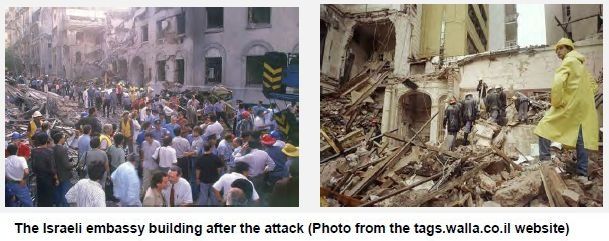
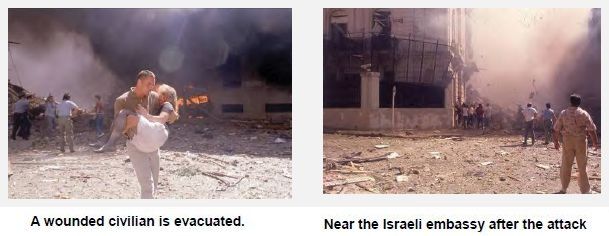


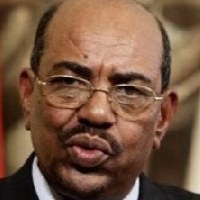
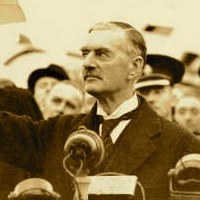
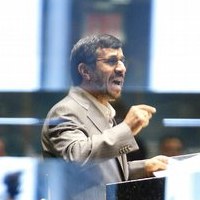
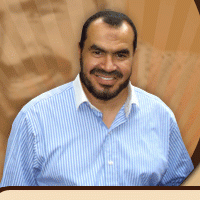








[…] To read Appendix II, go here: Hezbollah’s Terrorist Activities during the 1990s […]